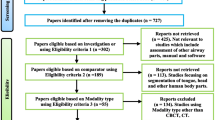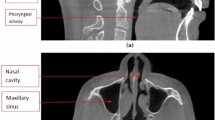Abstract
Purpose
The objective of the present study is to put forward a novel automatic segmentation algorithm to segment pharyngeal and sino-nasal airway subregions on 3D CBCT imaging datasets.
Methods
A fully automatic segmentation of sino-nasal and pharyngeal airway subregions was implemented in MATLAB programing environment. The novelty of the algorithm is automatic initialization of contours in upper airway subregions. The algorithm is based on boundary definitions of the human anatomy along with shape constraints with an automatic initialization of contours to develop a complete algorithm which has a potential to enhance utility at clinical level. Post-initialization; five segmentation techniques: Chan-Vese level set (CVL), localized Chan-Vese level set (LCVL), Bhattacharya distance level set (BDL), Grow Cut (GC), and Sparse Field method (SFM) were used to test the robustness of automatic initialization.
Results
Precision and F-score were found to be greater than 80% for all the regions with all five segmentation methods. High precision and low recall were observed with BDL and GC techniques indicating an under segmentation. Low precision and high recall values were observed with CVL and SFM methods indicating an over segmentation. A Larger F-score value was observed with SFM method for all the subregions. Minimum F-score value was observed for naso-ethmoidal and sphenoidal air sinus region, whereas a maximum F-score was observed in maxillary air sinuses region. The contour initialization was more accurate for maxillary air sinuses region in comparison with sphenoidal and naso-ethmoid regions.
Conclusion
The overall F-score was found to be greater than 80% for all the airway subregions using five segmentation techniques, indicating accurate contour initialization. Robustness of the algorithm needs to be further tested on severely deformed cases and on cases with different races and ethnicity for it to have global acceptance in Katradental radKatraiology workflow.










Similar content being viewed by others
References
Cossellu G, Biagi R, Sarcina M, Mortellaro C, Farronato G (2015) Three-dimensional evaluation of upper airway in patients with obstructive sleep apnea syndrome during oral appliance therapy. J Craniofac Surg 26(3):745–748. doi:10.1097/scs.0000000000001538
Cui DM, Han DM, Nicolas B, Hu CL, Wu J, Su MM (2016) Three-dimensional evaluation of nasal surgery in patients with obstructive sleep apnea. Chin Med J 129(6):651–656. doi:10.4103/0366-6999.177971
Neugebauer J, Ritter L, Mischkowski RA, Dreiseidler T, Scherer P, Ketterle M, Rothamel D, Zoller JE (2010) Evaluation of maxillary sinus anatomy by cone-beam CT prior to sinus floor elevation. Int J Oral Maxillofac Implants 25(2):258–265
Sam K, Lam B, Ooi CG, Cooke M, Ip MS (2006) Effect of a non-adjustable oral appliance on upper airway morphology in obstructive sleep apnoea. Respir Med 100(5):897–902. doi:10.1016/j.rmed.2005.08.019
Sforza E, Bacon W, Weiss T, Thibault A, Petiau C, Krieger J (2000) Upper airway collapsibility and cephalometric variables in patients with obstructive sleep apnea. Am J Respir Crit Care Med 161(2):347–352. doi:10.1164/ajrccm.161.2.9810091
Shepard JW Jr, Burger CD (1990) Nasal and oral flow-volume loops in normal subjects and patients with obstructive sleep apnea. Am Rev Respir Dis 142(6 Pt 1):1288–1293. doi:10.1164/ajrccm/142.6_Pt_1.1288
Souza FJ, Evangelista AR, Silva JV, Perico GV, Madeira K (2016) Cervical computed tomography in patients with obstructive sleep apnea: influence of head elevation on the assessment of upper airway volume. J Brasil Pneumol 42(1):55–60. doi:10.1590/s1806-37562016000000092
Wang T, Yang Z, Yang F, Zhang M, Zhao J, Chen J, Li Y (2014) A three dimensional study of upper airway in adult skeletal Class II patients with different vertical growth patterns. PLoS ONE 9(4):e95544. doi:10.1371/journal.pone.0095544
White SM, Huang CJ, Huang SC, Sun Z, Eldredge JD, Mallya SM (2015) Evaluation of the upper airway morphology: the role of cone beam computed tomography. J Calif Dental Assoc 43(9):531–539
Eslami E, Katz ES, Baghdady M, Abramovitch K, Masoud MI (2016) Are three-dimensional airway evaluations obtained through computed and cone-beam computed tomography scans predictable from lateral cephalograms? A systematic review of evidence. The Angle Orthod. doi:10.2319/032516-243.1
Alsufyani NA, Hess A, Noga M, Ray N, Al-Saleh MA, Lagravere MO, Major PW (2016) New algorithm for semiautomatic segmentation of nasal cavity and pharyngeal airway in comparison with manual segmentation using cone-beam computed tomography. Am J Orthod Dentofac Orthop 150(4):703–712. doi:10.1016/j.ajodo.2016.06.024
Dastidar P, Heinonen T, Numminen J, Rautiainen M, Laasonen E (1999) Semi-automatic segmentation of computed tomographic images in volumetric estimation of nasal airway. European archives of oto-rhino-laryngology : official journal of the European Federation of Oto-Rhino-Laryngological Societies (EUFOS): affiliated with the German Society for Oto-Rhino-Laryngology. Head Neck Surg 256(4):192–198
Salerno S, Gagliardo C, Vitabile S, Militello C, La Tona G, Giuffre M, Lo Casto A, Midiri M (2014) Semi-automatic volumetric segmentation of the upper airways in patients with pierre robin sequence. Neuroradiol J 27(4):487–494. doi:10.15274/nrj-2014-10067
Weissheimer A, Menezes LM, Sameshima GT, Enciso R, Pham J, Grauer D (2012) Imaging software accuracy for 3-dimensional analysis of the upper airway. Am J Orthod Dentofac Orthop 142(6):801–813. doi:10.1016/j.ajodo.2012.07.015
Tingelhoff K, Moral AI, Kunkel ME, Rilk M, Wagner I, Eichhorn KG, Wahl FM, Bootz F (2007) Comparison between manual and semi-automatic segmentation of nasal cavity and paranasal sinuses from CT images. In: Conference proceedings: annual international conference of the IEEE engineering in medicine and biology society IEEE engineering in medicine and biology society annual conference 2007, pp 5505–5508. doi:10.1109/iembs.2007.4353592
Huang R, Li A, Bi L, Li C, Young P, King G, Feng DD (2016) Kim J A locally constrained statistical shape model for robust nasal cavity segmentation in computed tomography. In: 2016 IEEE 13th International symposium on biomedical imaging (ISBI), 13–16 April 2016, pp 1334–1337. doi:10.1109/ISBI.2016.7493513
Jinda-apiraksa A, Ongt SH, Hiew LT, Foong KWC, Kondo T (2009) A segmentation technique for maxillary sinus using the 3-D level set method. In: TENCON-2009 IEEE region 10 conference, 23–26 Jan. 2009, 2009, pp 1–6. doi:10.1109/TENCON.2009.5396044
Bui NL, Ong SH, Foong KW (2015) Automatic segmentation of the nasal cavity and paranasal sinuses from cone-beam CT images. Int J Comput Assist Radiol Surg 10(8):1269–1277. doi:10.1007/s11548-014-1134-5
Last C, Winkelbach S, Wahl FM, Eichhorn KWG, Bootz F (2010) A model-based approach to the segmentation of nasal cavity and paranasal sinus boundaries. In: Goesele M, Roth S, Kuijper A, Schiele B, Schindler K (eds) Pattern recognition: 32nd DAGM symposium, Darmstadt, Germany, September 22–24, 2010. Proceedings. Springer Berlin Heidelberg, Berlin, Heidelberg, pp 333–342. doi:10.1007/978-3-642-15986-2_34
Shi H, Scarfe WC, Farman AG (2006) Upper airway segmentation and dimensions estimation from cone-beam CT image datasets. Int J Comput Assist Radiol Surg 1(3):177–186. doi:10.1007/s11548-006-0050-8
Cheng I, Nilufar S, Flores-Mir C, Basu A (2007) Airway segmentation and measurement in CT images. In: Conference proceedings: annual international conference of the IEEE engineering in medicine and biology society IEEE engineering in medicine and biology society annual conference 2007, pp 795–799. doi:10.1109/iembs.2007.4352410
Shi H, Scarfe WC, Farman AG (2006) Maxillary sinus 3D segmentation and reconstruction from cone beam CT data sets. Int J Comput Assist Radiol Surg 1(2):83–89. doi:10.1007/s11548-006-0041-9
Lankton S, Tannenbaum A (2008) Localizing region-based active contours. IEEE Trans Image Process 17(11):2029–2039. doi:10.1109/TIP.2008.2004611
Chan TF, Vese LA (2001) Active contours without edges. IEEE Trans Image Process 10(2):266–277. doi:10.1109/83.902291
Caselles V, Kimmel R, Sapiro G (1997) Geodesic active contours. Int J Comput Vis 22(1):61–79. doi:10.1023/a:1007979827043
Vezhnevets V, Konouchine V GrowCut (2005) Interactive multi-label ND image segmentation by cellular automata. In: Proceedings of the graphicon, pp 150–156
Lankton S (2009) Sparse field methods-Technical report. Georgia Institute of Technology
Gupta A, Kharbanda OP, Balachandran R, Sardana V, Kalra S, Chaurasia S, Sardana HK (2017) Precision of manual landmark identification between as-received and oriented volume-rendered cone-beam computed tomography images. Am J Orthod Dentofac Orthop 151(1):118–131. doi:10.1016/j.ajodo.2016.06.027
Smith T, Ghoneima A, Stewart K, Liu S, Eckert G, Halum S, Kula K (2012) Three-dimensional computed tomography analysis of airway volume changes after rapid maxillary expansion. Am J Orthod Dentofac Orthop 141(5):618–626. doi:10.1016/j.ajodo.2011.12.017
Guijarro-Martinez R, Swennen GR (2013) Three-dimensional cone beam computed tomography definition of the anatomical subregions of the upper airway: a validation study. Int J Oral Maxillofac Surg 42(9):1140–1149. doi:10.1016/j.ijom.2013.03.007
Vasamsetti S, Sardana V, Kumar P, Kharbanda O, Sardana H (2015) Automatic landmark identification in lateral cephalometric images using optimized template matching. J Med Imaging Health Inform 5(3):458–470
Loy G, Eklundh J-O (2006) Detecting symmetry and symmetric constellations of features. In: Leonardis A, Bischof H, Pinz A (eds) Computer vision—ECCV 2006: 9th European conference on computer vision, Graz, Austria, May 7–13, 2006. Proceedings, Part II. Springer Berlin Heidelberg, Berlin, Heidelberg, pp 508–521. doi:10.1007/11744047_39
Abdolali F, Zoroofi RA, Otake Y, Sato Y (2016) Automatic segmentation of maxillofacial cysts in cone beam CT images. Comput Biol Med 72:108–119. doi:10.1016/j.compbiomed.2016.03.014
Author information
Authors and Affiliations
Corresponding author
Ethics declarations
Conflict of interest
Bala Chakravarthy Neelapu, Om Prakash Kharbanda, Viren Sardana, Abhishek Gupta, Srikanth Vasamsetti and Harish Kumar Sardana would like to declare that a provisional Indian patent and US/PCT filing is in progress for the proposed algorithm.
Ethical approval
For this type of study, formal consent is not required.
Informed consent
Informed consent is taken from individual patient.
Rights and permissions
About this article
Cite this article
Neelapu, B.C., Kharbanda, O.P., Sardana, V. et al. A pilot study for segmentation of pharyngeal and sino-nasal airway subregions by automatic contour initialization. Int J CARS 12, 1877–1893 (2017). https://doi.org/10.1007/s11548-017-1650-1
Received:
Accepted:
Published:
Issue Date:
DOI: https://doi.org/10.1007/s11548-017-1650-1




